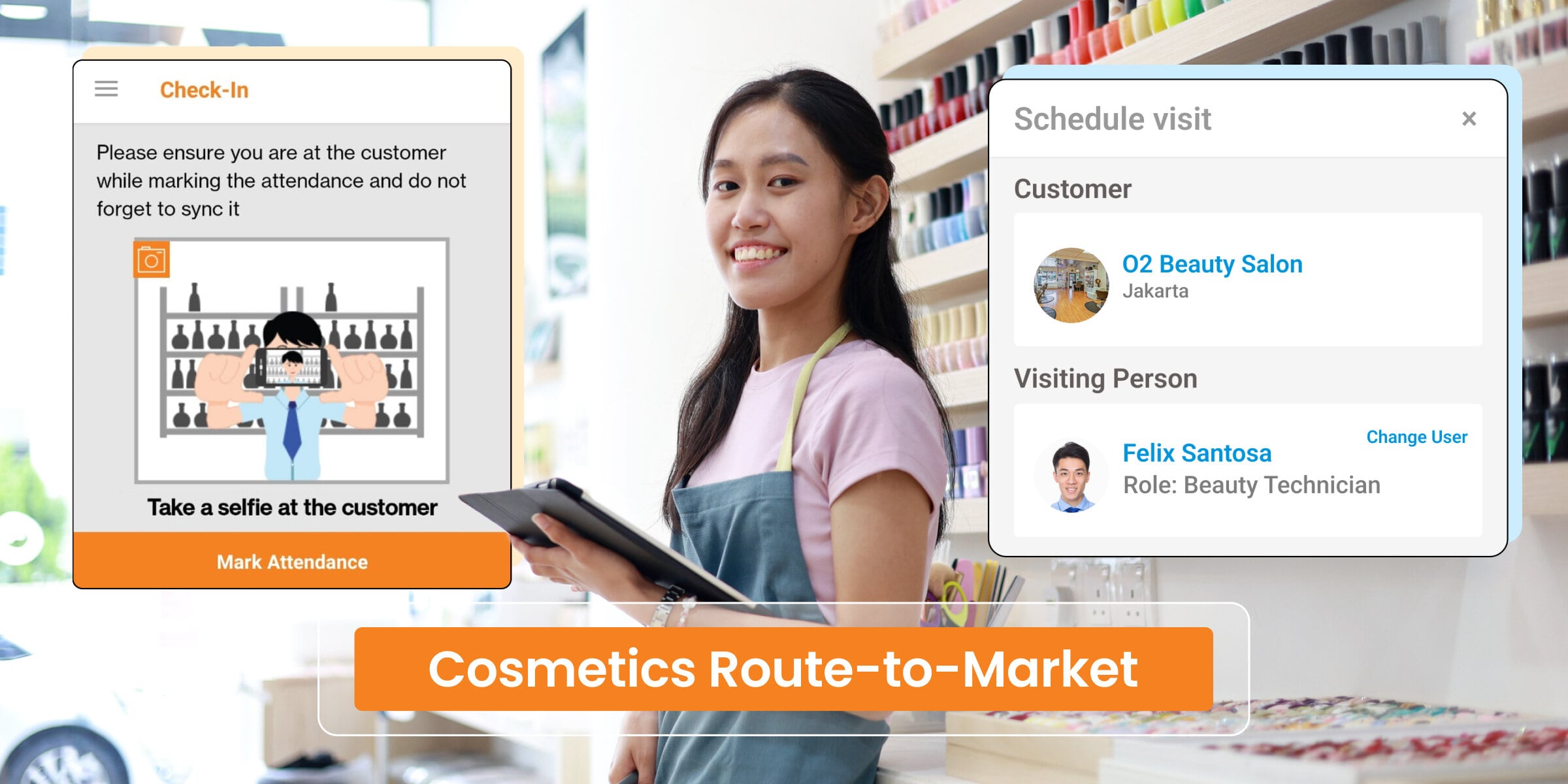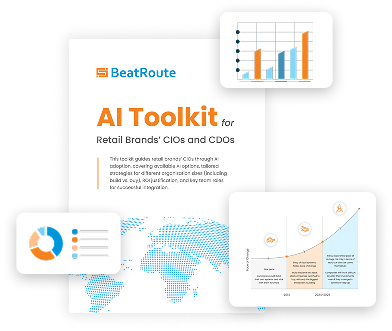Driving Successful Route to Market in Cosmetics Industry Across Retail and Salon Channels

Cosmetics brands face distinct route-to-market challenges compared to FMCG brands, partly due to the nuances of their products. Cosmetics brands focus on product application techniques, product demos by technical teams, and consumer education to drive sales that FMCG brands don’t need to do that much due to the relatively simpler nature of their products.
There are two main channels in the cosmetics industry – retail (general and modern trade) and salons. The retail channel requires greater focus on beauty advisors, product visibility, and consumer education to drive growth. On the other hand, the salon channel is unique to the cosmetics industry and is more nuanced in its execution than retail. It necessitates a combination of onboarding, pipeline management, continuous relationship management, and proper B2B-esque engagement for driving growth.
Although both are active in the same industry, retail and salon channels have different processes with different KPIs and challenges. Keeping with that understanding, we have segregated this article into two parts – one discussing the route-to-market challenges and solutions for the retail channel, and one discussing the same for the salon channel. We’ll use our platform’s capabilities to suggest practical solutions at every step.
By the end of this piece, you should be in a position to grasp every concept, overcome every roadblock, and enhance your route to market activities in the cosmetics industry significantly.
Challenges To Overcome in Retail Channel
While many of the challenges in the cosmetics industry’s retail channel are common with FMCG industry, we are going to focus primarily on challenges which are more pronounced in cosmetics.
Consider that you have recently launched a new moisturiser and it’s head and shoulders above what others are offering. It offers double the moisturisation than the top product in the market currently. Your sales reps do an excellent job of getting these products placed at various premium retail outlets and even some general/kirana stores.
You are all set and now it’s all about the offtake, right?
You have a great product, your packaging reveals all the benefits, and you have placed your products in stores which align with the profile you are looking for. Why would anything go wrong? But something does. You notice that your tertiary sales are suboptimal. An investigation reveals that your beauty advisors at these outlets have been starting their shifts late or leaving early, thereby unable to engage an adequate number of consumers during peak time.
You also find that they are unable to educate consumers about your products because they themselves don’t know much. Despite being top of the line, your product is relegated to a corner of the shelf and your competitors’ are taking advantage of this and selling more of their potentially inferior offerings.
This necessitates that you look deeper into what needs improving in your route to market. Because lack of sufficient offtake also affects secondary and primary sales negatively. And everyone loses, especially you.
We elaborate each issue in the following list followed by a section on solutions.
- Cosmetics are more complicated than, say, some other industries because of their specific uses, conditions, and application techniques. This makes product-educated beauty advisors crucial to tertiary sales at retail stores because consumers are more likely to purchase something, especially cosmetics products, when they understand their USPs.
For example, you may have launched a shampoo cum conditioner product in the market very recently whose USP is 3x silkier hair. A beauty advisor may instead change this positioning and instead highlight the cost saving as the main USP. As many customers associate price with quality, it might not have been your strategy to highlight cost effectiveness as your product’s primary selling point.
Brands also need to be mindful of the fact that communicating on a whim is not enough. If you launch a product today and communicate its educational content to the beauty advisor a week later, it’s inevitably going to lead to lost sales. Instead, a consistent stream of communication that aligns with every update, every formulation, and every launch is crucial to keep beauty advisors in the loop about all products.
The same is true for stores where brands don’t place a beauty advisor; the retailer or retail staff has to educate consumers on your products. If they don’t receive some form of knowledge from sales reps, the brand’s digital channel or merchandiser that’s consistent or regular, they won’t be in a position to educate customers about your products. In all such cases, your brand image takes a hit in addition to sales loss.
- Beauty advisors are placed in stores for the primary purpose of educating and convincing consumers to buy from you. For this, brands set specific times or shifts that need to be adhered to in order to engage the maximum number of consumers. When this doesn’t happen, i.e. beauty advisors arrive late or leave early, it is a given that sales will never be up to expectations. They fail to engage consumers during peak hours and as a result, your products remain on shelves when they could have been in customer bags. This raises a potent problem regarding beauty advisor attendance.
- Many times, consumers leave without your product or get the competitor’s because they can’t find yours. This could be because of understocking that leads to quick outages or inadequate visual merchandising for which no consumer is able to notice your products. Both visibility and availability issues occur from a lack of in-store monitoring. Maybe sales reps aren’t visiting stores regularly or are failing to document their findings or maybe the in-store beauty advisors are unable to keep track of all the focus SKUs or maybe the retailer cannot place orders in the event of a stock outage. Without clear communication about what’s happening in the store, there is no way to neutralise stock issues or attract consumer attention via effective visual merchandising.
In case of visibility shortcomings, where consumers are unable to find your products in a sea of products, the problem lies squarely on the fact that your merchandising is not up to par. In an attempt to fix this, maybe your sales reps are noting issues on a piece of paper that may be lost. Maybe there is a delay in assigning the problem to the merchandising team or equivalent. So, even though efforts are being made to fill merchandising gaps, you may be going about it the wrong way!
- Much of the sales drop that you notice at general trade stores or sales reps underperforming on their targets is due to a lack of product knowledge. They don’t know the product or can’t remember what they learned about it at some point, and they end up miscommunicating or failing to convince the store owner to stock up on it. In modern stores, beauty advisors whose job is to enhance tertiary sales, fail at it because they don’t know or are not confident about their products.
Running a Successful Route to Market in Retail Channel
- Enable Beauty Advisors With Powerful and Monitored Product Content
Good sales in the cosmetics industry is ensured when consumers understand your product before purchasing. This is only possible when those responsible for promoting your product and driving sales, the beauty advisors, are knowledgeable and confident about your offerings. Consistent access to regularly updated learning content such as multimedia videos will enable beauty advisors to do a better job at persuading consumers. At the same time, product videos may be made available to these beauty advisors to play for consumers for added persuasion. This can also be tracked by the brand.
- Educate, Inspire and Incentivise Retailers
In stores where beauty advisors may not be available, sales reps and merchandisers educate retailers about the product, its application, and benefits. With the right loyalty program in place (such as winning redeemable points for sales milestones), a product-aware retailer will do the extra bit to promote or push your products to consumers. This information may also be gleaned from the brand’s customer app where retailer-focused product information may be made available.
- Ensure Timely In-Store Presence for Beauty Advisors
Beauty advisors who don’t adhere to their brand-defined shift timings are almost as pointless as having no beauty advisors; they don’t drive much offtake. They come and go as they please when there’s no way to track their in-store presence. To counteract this, a system that necessitates them entering their shift start and end times is highly recommended. A reliable system may provide total visibility on which beauty advisors are compliant to their shifts and which aren’t. Apart from clarity on if your beauty advisors are engaging peak crowds for max sales or not, such data also allows you to take corrective actions, such as resource reallocation, in time.
- Eliminate Stock-Outs Via Accurate Reporting
It is easy to grasp that consumers will only buy what they can see and recognise as beneficial to them. While the benefits can be communicated via product-aware beauty advisors or retailers, it is beyond important that consumers actually see or find your products on shelves. This means you need to address stockouts and merchandising issues promptly and that is only possible through systemised information gathering.
Brands dictate stock norms (number of units per SKU in each store) for stores that must be adhered to and any deviation from these norms means that it’s time to replenish your stock; alerts may be triggered for such deviations. Sales reps and beauty advisors equipped with powerful and versatile software with multimedia (images, videos, text) capabilities are also able to capture everything accurately. This information then gets adequately disseminated to the right people/teams/departments for quick resolutions.
Additionally, having your general trade retailers on your brand’s app with ordering capabilities allows for them to place orders whenever stocks are low, reducing the dependency on sales rep visits for ordering, especially when the need is immediate.
- Bolster Sales Rep Capabilities with Consistent Product Knowledge
If you expect your sales reps to do a great job of convincing general trade stores to stock up on your products, the first thing that you should ensure is that your sales reps get access to product knowledge on a regular basis.
Consider their role – Your sales reps have to engage retailers on a regular basis, resolve issues(when possible) or document them, clarify doubts, and pitch new launches. Any such interaction requires your sales rep to know your product inside out, especially in the cosmetics industry where application and formulation are critical, to ensure they can do their job. Brands can also relay knowledge via a reliable sales app where multimedia learning videos or content can consistently improve sales rep knowledge. As discussed in the first point of this section, the same goes for beauty advisors.
Challenges to Overcome in Salon Channel
Salons are somewhat akin to a B2B channel and their primary role isn’t to sell cosmetics. They offer hairdressing, styling, and spa services for which they buy and apply cosmetic products such as shampoos, conditioners, hair colours, body creams, waxing products, etc. from brands and apply them on customers. Additionally, they may also try to convince their customers to buy some of these products. Stylists, who directly interact with customers, require every bit of knowledge about the said products not only to apply them but also to answer customer questions about them.
Remember, the more salons use your products in their services, the more they will buy from you. The more they buy, the more your sales. This depends on a number of factors such as proper application, customer satisfaction, rewards/incentives, and regular engagement.
We discuss these problems and their solutions in this and the following section.
- Blindly onboarding salons, without keeping in mind that your product might not match every salon profile, results in lost sales; salons don’t use it adequately (resulting in stunted repeat business for you) and neither are they able to convince their customers to buy it. Every salon is particular in terms of size, target customers, location, sales potential and so on. For example, placing a premium hair dye in a small salon in a middle-class neighbourhood inhabited by people of modest means isn’t going to get you the ROI you are looking for. WIthout adequate research into factors like location and sales potential of salons, your products will waste away on the wrong shelves.
- Consider that your sales reps have to visit new salons frequently and onboard as many as possible to both increase your network and replace churned customers. They are speaking to new salon owners regularly and it can get hard to keep a mental or paper note of the different stages of a pipeline. Without a lead management software to manage pipelines across several salons, it is very likely that sales reps will forget or lose track of leads, often leading to a long process of conversion (including product demo scheduling) that puts off salon owners.
- Stylists need to know all about your products to be able to apply them in the right way and quantity. There are also scenarios where customers show preferences for certain brands before application and stylists need to advise or persuade them to go for another brand. An example is hair-treatment products where the customer may prefer X from past good experiences even though Y is a better product. An uninformed stylist will not change things here and therefore, it’s in a brand’s interests to keep stylists updated with product launches, features, benefits, application, and so on. This means that onboarding salons isn’t enough to guarantee offtake; regular training and retraining of stylists is mandatory.
However, in the absence of a systemised approach, it is very hard to keep track of who attended previous training sessions and who needs to be retrained on updated product features or its application. Additionally, without a system, sales reps may find it difficult to assign technical team members to training sessions/events and instead have to navigate a tedious process to do so.
- Stylists who are not inspired to use or push your products to salon customers will not do so. There are many competitor brands that are also vying for shelf space in these salons. The only way for you to ensure preference for your products is if you ensure loyalty from these salons, especially their stylists. Of course, they need to be incentivised with reward points or gifts but without visibility on where they stand with points or what the next milestone is, it’s not good enough. Without giving them easy access to their accumulated rewards and how good or bad they are doing, you will never see the kind of return on your investment that you expect.
- Low engagement gives your competitors an opening to pull a salon’s business to them. Maybe your sales reps are not able to document and escalate product/order issues in time or provide updates on them or missed a salon visit altogether or maybe stylists don’t find your schemes lucrative at all. Without adequate engagement that brings these problems to the fore and also keeps your brand relevant and fresh in the minds of salon owners, you are going to see less and less offtake.
- In the salon channel, relationships with cosmetics brands are often built on the quality of product education and support. However, much like general trade, salon owners are incentivized by well-designed schemes that encourage them to stock up or expand their range. But even the most enticing offers fall flat if salons aren’t made aware of them.
If your schemes aren’t clearly communicated to your salon partners and distributors, they won’t feel motivated to purchase or promote your products. Without visibility into the discounts, redeemable points or progress toward their next target, that extra drive to use and sell your brand in their salon fades.
Running a Successful Route to Market in Salon Channel
- Guarantee Correct Onboardings for Ideal Sales
Even before you think of placing your products in a salon, your first priority should be to profile your salons based on sales potential, location, consumer types in the area, etc. This would ensure you sell the right cosmetics products to the right salon that you have on-boarded after ensuring they are relevant to your goals and product types. A reliable system/software/sales app would help ensure that sales reps capture every metric or data the brand deems necessary before onboarding a salon, mitigating lost sales and instead enhancing it.
- Put a Reliable Pipeline Management Mechanism in Place
Say you receive a lead via your social media handle. A moderator or admin passes this on to a sales rep who notes it down after checking their message some time later, follows through after dealing with current commitments, meets the salon owner, convinces them to try a demo and then it takes another week for the technical team to send someone down to the salon. By this time, the salon owner may have lost interest and you are down a lead.
This is easily avoidable with the presence of a robust lead management system that can auto-allocate leads to relevant stakeholders in time. An additional bonus would be the presence of a coworking mechanism between the sales rep and the technical team with the former able to manually assign the latter on the sales app itself, instead of simply calling or messaging. This would not only shorten the overall pipeline journey, but more importantly, introduce efficiency and promptness to it.
- Don’t Compromise on Training Stylists Regularly on your Products
Timely training for stylists needs to be set up while onboarding salons because the sooner they understand your product, the better they will be at using them, leading to customer satisfaction, more use, and ultimately more sales for you. To train stylists on a product or to train them on a new launch, sales reps can assign the appropriate technical specialist to the salon/stylists on their app or system; training records are maintained with which the brand will always have clarity on who needs training and when. Such a coworking mechanism, where the sales team and technical specialists work together to keep stylists educated on products, is extremely helpful to ensure successful offtake.
- Leverage the Propensity of Rewards for Driving Sales
While learning inspires confidence, rewards inspire the drive to use or pitch something. Educating stylists prepares them for product application, communication, and even brand promotion, but at the same time, rewarding them for using or getting your products sold gives them incentive to do so. To that end, your loyalty program must incorporate rewards that stylists can win after accomplishing certain milestones. They will also appreciate visibility on their own screens to work towards the next sales target or milestone that will earn them points. It will create a drive in them to go the extra mile for you.
- Encourage Brand-Salon Engagement to Sustain Relationships
Regular engagement between your sales reps and salons is a must to ensure your relevance in the minds of your customers. Be it issue flagging/resolution or stylists not performing to your standards, consistent dialogue is necessary. This can only be done effectively when there is a systematic approach in effect. With the right system such as BeatRoute’s sales app that can provide AI suggestions to sales reps on which salons need visiting, you eliminate the need to remember or intuitively decide. Relationship management and addressing problems take the front seat without wasting time where resources need not be sent.
- Give Scheme Visibility to Both Sales Team and Salon Partners
Schemes encourage salon owners to purchase more or broaden their product offerings. The goal is to make buying from your brand more appealing than turning to competitors, driving revenue growth through stronger sales. However, the biggest and simplest barrier to effective scheme utilisation is that many salon owners aren’t even aware of them.
To address this challenge, two key solutions can be implemented:
- Sales reps should have full visibility of schemes available for that salon. This equips them to confidently recommend the best product combinations and never miss out on any sales opportunity.
- Salon partners should have access to these schemes through a brand-provided app during the ordering process, giving them clear incentives to make larger or more frequent purchases, ultimately boosting sales for your brand.
Summing Up This Article
The cosmetics industry, with all its complexity and differences from other industries but particularly FMCG, requires special attention to problems. While availability and visibility take centre stage in route-to-market (RTM) efforts in the retail channel, the salon channel necessitates that you take added care to ensure stylists are educated on your products; product training and engagement is crucial. Only when you have all the solutions in place can you hope to soar above the problems in the cosmetics industry.
Leading brands across the globe trust us to help them overcome all the roadblocks in their RTM strategy and so can you. Contact us for a free demo today!
About the Author
-
Apart from being a Senior Content Writer at BeatRoute, Soham is an avid reader of science fiction and suspense novels (Doyle, Christie, Brown or anybody great!) He also dabbles in historical narratives and wonders about our place in the universe. Cosmic viewpoints, Carl Sagan, and Neil deGrasse Tyson intrigues him. When not reading, you may find him spending his weekends or after-work hours watching a fulfilling movie with his family.
Use Goal-Driven AI to Achieve Retail Sales Uplift, Today!
Join enterprises in 20+ countries that trust BeatRoute, the globally dominant AI platform for sales force automation, field sales, DMS, and eB2B
Latest Insights & Articles
Here are the most impactful articles, platform updates, ebooks and reports for you.



